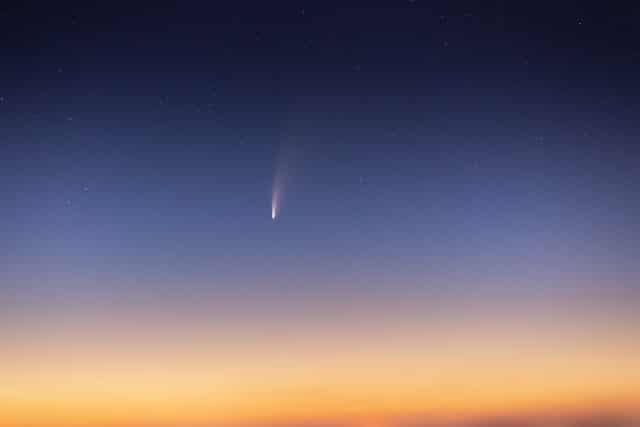On October 19th, 2017 Robert Weryk turned to a new part of the sky with the Pan-STARRS telescope at Haleakalā Observatory in Hawaii and spotted something that would earn him international acclaim and leave physicists and astronomers scratching their heads for years. Scientists have long pondered the possibility of Interstellar Travel. Even though, Weryk might not be the first astronomer to discover how to travel outside our solar system he just might be the first astronomer to discover evidence of Interstellar Travel. No, it’s not Aliens. Well, actually, it might be Aliens. Whatever it is, scientists have finally settled on the name ‘Oumuamua which is Hawaiian for scout. The name alone tells us they know what we hope it is, Aliens.
‘Oumuamua Moving Through The Night Sky
‘Oumuamua is a relatively small object (between 300 and 3000 feet in length) floating through space. Initially, scientists classified the object as a comet. Comet’s, however, always are trailed by a coma, or tail of ice. Since ‘Oumuamua lacks any sort of coma scientists concluded it could not be a comet and reclassified the object as an asteroid. Astronomers observed the flight path and other odd characteristics displayed by ‘Oumuamua and confirmed the need for yet another designation as the first known interstellar object to pass through our solar system.

Photo by Daniil Silantev on Unsplash
Needless to say, news of the interstellar object passing by earth picked up quite a thunderous crowd of scientists hoping to catch a glimpse of the weary traveler. Physicists theorized the materials from which the object is composed. Astronomers tried to triangulate the origins of the visitor. Others saw it as an opportunity to finally prove the existence of extraterrestrial life. ‘Oumuamua clearly brought a sense of wonder to all who heard of it.
Ok, but what is so special about a floating rock?
This isn’t just any regular floating space rock. ‘Oumuamua, officially classified as 1I/2017 U1, does not bear characteristics that match any current understanding of all the other floating space rocks. It exhibits a non-gravitational form of acceleration, which just means that it is not moving do to an orbit of a celestial body. Instead ‘Oumuamua seems to have some sort propulsion pushing it through the cosmos.
It also appears to be tumbling end over end, or wobbling, in a rather unnatural manner. Most scientists agree the tumble is evidence of a previous collision. Others have, well, other theories but we’ll get to that. ‘Oumuamua is relatively thin, somewhere between 115 and 548 feet in depth. This cosmic pancake flipping through space not adhering to gravitational forces is forging its own route through our galaxy and likely beyond. Scientist aren’t sure where the object came from and they aren’t quite sure where it is going. What astronomers know for sure; ‘Oumuamua is really special.
I Was Promised Aliens
All good space mysteries have aliens, right? Well duh. ‘Oumuamua is no different. An array of rather distinguished scientist have theorized that there is a mounting collection of evidence pointing towards this object being the space craft from some far flung Alien Civilization. Galactic Federation anyone?
Avi Loeb, a theoretical physicist with a focus on astrophysics and cosmology at Harvard, believes that the only realistic explanation for such an object is intelligent life. Loeb theorized that ‘Oumuamua could be an interstellar solar sail. Solar sails are a form of space travel that captures thrust from light waves and rides them much like a sail boat is pushed by the wind. According to Loeb the solar sail theory explains the objects shape and non-gravitational acceleration.
Over the past three years, Loeb has become more and more passionate about his claims. He and his research assistant have searched the night sky for other interstellar visitors and have actually found four other candidates. Earlier this year Loeb even published a book on the subject, you can get that here.
Conclusion
‘Oumuamua is certainly one of the most interesting things to float by our little blue planet. Regardless of what it might actually be, this interstellar visitor defies most of what we know about similar objects. For that reason alone it is worth our admiration. And if scientists like Avi Loeb are correct, there’s a whole lot more out there to be discovered. We just need to look up.
If you watched or listened to this episode then check out this handy new tool: How Many 737s?
Sources
Interstellar Object – Wikipedia
Non-Gravitational Acceleration – Wikipedia
Small Asteroid or Comet ‘Visits’ from Beyond the Solar System – Nasa
Let us know what you think of this content!
And hey, if you liked this make sure to share it with your friends! Hit one of those social links below!

